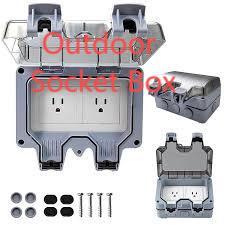A thoughtfully specified Outdoor Socket Box placed in the right location can dramatically reduce service time and protect connections from weather-related damage. For facility managers and installers, the right exterior enclosure reduces moisture ingress, keeps terminations clean, and provides an organized point for temporary hookups and routine inspections. This article examines design choices, installation practices, and maintenance routines that help teams get consistent, long-term performance from exterior power outlets.
1. Matching Enclosure Features to Site Needs
Start by mapping the environmental stressors at the installation site. Is the location exposed to driving rain, salt-laden air, dust, or frequent mechanical impact? Choose housings with UV-stable polymers or corrosion-resistant metals depending on the risk profile. Look for continuous-seal gaskets and latching systems engineered to maintain compression after repeated opening. Internal space should permit tidy conductor routing and allow protected placement of terminal strips and protective fuses, so upgrades or testing do not require full disassembly.
2. Practical Layouts That Speed Up Field Work
An organized interior layout shortens diagnostic time. Provide clearly separated wiring zones, captive fasteners to prevent dropped hardware, and mounting rails sized for standard modules. Design the box so technicians can reach common test points without moving other conductors. Add labeling areas and color-coded terminal blocks to reduce confusion during night shifts or low-visibility inspections. Small touches like tool trays and routing guides help teams work faster and reduce the chance of accidental shorts or cross-connections.
3. Cable Entry, Glands, and Mechanical Protection
The longevity of an exterior socket point often hinges on how cables enter and are secured. Use properly rated cable glands and strain relief hardware sized to conductor bundles, and avoid ad-hoc feed-throughs. Protect cables from abrasion with sleeves or grommets at sharp edges. Where flexible cabling moves regularly, provide service loops and anchor points to prevent fatigue at terminations. Thoughtful gland placement and robust strain relief prevent the most common mechanical failures in exposed installations.
4. Serviceability and Spare-Part Planning (Nante Options)
Select enclosures that accept replaceable inserts or standardized modules so worn or damaged components can be swapped quickly. Having a local spare kit — replacement gaskets, a common outlet module, and a latch set — significantly shortens downtime when faults occur. When procuring equipment, ask about available accessory kits and whether the supplier publishes exploded parts diagrams; these resources speed repairs and simplify training for new technicians.
5. Installation Techniques That Preserve Ratings
Installation practices influence whether a product performs to its rated protection. Mount boxes to avoid creating water traps; ensure doors open away from prevailing splash; and maintain recommended clearance for drainage. Use compatible glands and follow manufacturer torque values on fasteners so gaskets compress evenly. Perform a water-spray verification after installation to confirm sealing, and document orientation and torque values in the site handover pack for future audits.
6. Routine Inspection and Preventive Maintenance
A small investment in periodic checks prevents most failures. Inspect gasket compression, fastener torque, and signs of UV embrittlement or chemical attack on housings. Verify that cable glands remain tight and that internal terminations show no signs of corrosion or overheating. Keep a simple maintenance log noting parts replaced and observed wear; over time this log reveals patterns that predict part lifetimes and justify stocking particular spares.
7. Upgrades, Modularity, and Lifecycle Thinking
Plan for change. Use modular mounting patterns and leave space for expansion so circuits can be added without invasive rework. Standardize on module types across multiple sites to reduce spare-part complexity. Treat the enclosure as an asset: schedule gasket replacements and door-latch inspections at regular intervals rather than waiting for failure. Lifecycle planning reduces emergency shipping costs and keeps field teams focused on preventive tasks that save money long term.
Well-designed exterior socket enclosures combine appropriate materials, neat internal layouts, correct installation methods, and modest preventive maintenance to deliver reliable power distribution outdoors. For product options, datasheets, and spare-part information, visit https://www.nante.com/product/

Join our community to interact with posts!